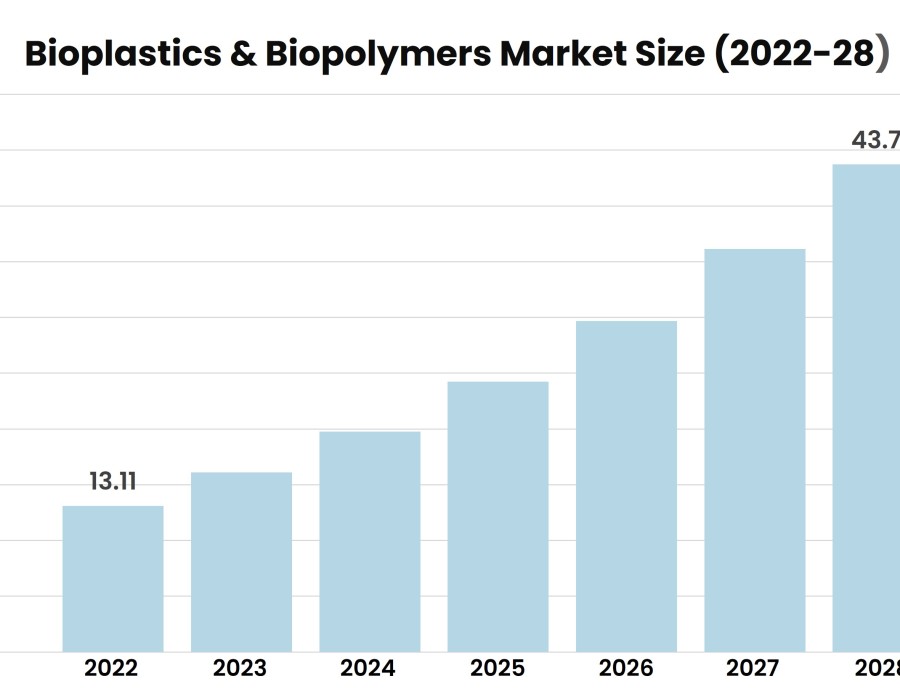The bioplastics and biopolymers industry is on the cusp of significant transformation, driven by innovations and evolving market demands. As sustainability becomes a central theme across industries, bioplastics and biopolymers are gaining traction as viable alternatives to traditional plastics. This article explores the emerging trends in the bioplastics and biopolymers market and what stakeholders can expect in the coming years.
According to Stratview Research, the bioplastics & biopolymers market was estimated at USD 13.11 billion in 2022 and is likely to grow at a CAGR of 22.1% during 2023-2028 to reach USD 43.72 billion in 2028.
1. Increased Adoption in Packaging
The packaging industry is one of the largest consumers of bioplastics and biopolymers. As brands and consumers prioritize sustainability, there is a growing shift towards using biodegradable and compostable packaging materials. Companies are investing in research and development to create packaging solutions that not only reduce environmental impact but also meet performance and safety standards. Expect to see more innovative packaging designs utilizing bioplastics in food, beverage, and consumer goods sectors.
2. Advancements in Biopolymer Production
Technological advancements are at the forefront of the bioplastics revolution. Innovations in fermentation processes, genetic engineering, and polymer chemistry are enabling the production of new biopolymers with enhanced properties. For instance, advancements in polylactic acid (PLA) production are improving its thermal and mechanical properties, making it suitable for a wider range of applications. Additionally, developments in polyhydroxyalkanoates (PHA) are enhancing its biodegradability and performance, driving its adoption in medical and packaging industries.
3. Diversification of Raw Materials
The reliance on a narrow range of feedstocks, such as corn and sugarcane, for bioplastic production is expanding to include a more diverse array of raw materials. Researchers are exploring the use of agricultural waste, algae, and non-food crops as feedstocks for biopolymer production. This diversification is expected to reduce competition with food resources, lower production costs, and enhance the sustainability of bioplastics.
4. Integration with Circular Economy Models
The concept of a circular economy is becoming increasingly relevant in the bioplastics industry. Companies are focusing on creating closed-loop systems where bioplastics can be recycled, composted, or repurposed into new products. This integration is expected to minimize waste, reduce resource consumption, and create a sustainable lifecycle for bioplastic products. Initiatives to improve the recyclability and compostability of bioplastics are gaining momentum, supported by regulatory frameworks and consumer demand.
5. Expansion into New Applications
While packaging remains a dominant application, bioplastics and biopolymers are making inroads into other industries. The automotive sector is exploring the use of bioplastics for interior components and lightweighting solutions. The electronics industry is adopting biopolymers for biodegradable circuit boards and casings. Additionally, the medical and pharmaceutical sectors are utilizing biopolymers for biodegradable implants, drug delivery systems, and eco-friendly medical devices. This expansion into new applications is expected to drive significant market growth.
6. Enhanced Consumer Awareness and Demand
Consumer awareness regarding the environmental impact of plastics is at an all-time high. This awareness is translating into increased demand for sustainable products, including those made from bioplastics. Brands are responding by incorporating bioplastics into their product lines and marketing their sustainability efforts. As consumers become more informed about the benefits of bioplastics, their demand is expected to grow, further propelling the market.
7. Regulatory Support and Policy Initiatives
Governments and regulatory bodies worldwide are implementing policies to promote the use of bioplastics and reduce reliance on conventional plastics. Bans on single-use plastics, incentives for biodegradable products, and stringent recycling targets are creating a conducive environment for the growth of the bioplastics market. These policy initiatives are encouraging manufacturers to innovate and adopt sustainable practices, thereby driving market expansion.
Conclusion
The future of the bioplastics and biopolymers industry is bright, with numerous emerging trends shaping its trajectory. Increased adoption in packaging, advancements in production technologies, diversification of raw materials, integration with circular economy models, expansion into new applications, enhanced consumer demand, and regulatory support are key trends to watch. As these trends unfold, the bioplastics and biopolymers market is poised for significant growth, offering sustainable solutions to global environmental challenges.






Comments